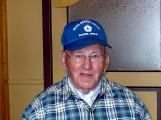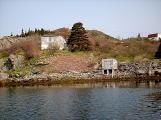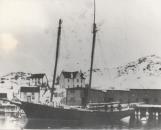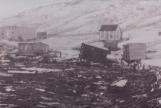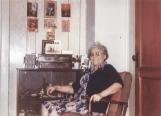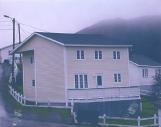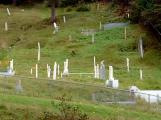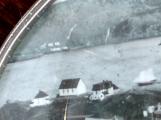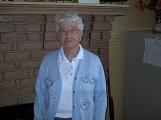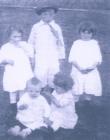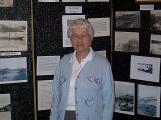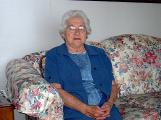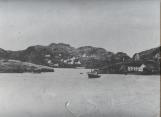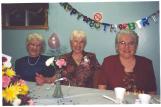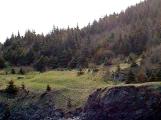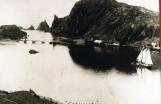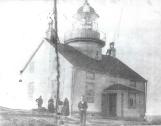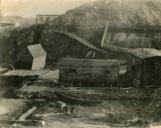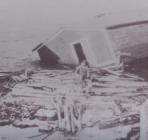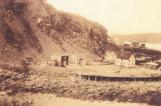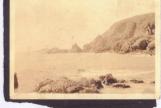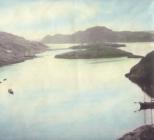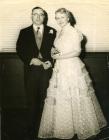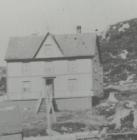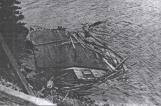

Burin Heritage House Inc.
Burin, Newfoundland and Labrador
1
Mr. Douglas Brushett lived in Bull's Cove, Burin during the Tidal Wave 1929. Mr. Brushett shares his memories of the Tidal Wave.3
"It was a beautiful fine evening, nice, and we were just outside the house. A little grassy place there, and it was two or three of us there at the time, and we heard a queer sound and after that the ground shook under our feet, trembled under our feet and we wondered what was happening. That was five o'clock in the evening. That was very well, so after supper, near the house, not very far from that, we used to always go playing cards. That's where we used to go in our night time. Got to pick up now this fella who played with playing cards, and the door, there was a fellow rushed in the house right fast, he said "Bull's Cove" he said, "is afloat."We all rushed outside. We tried to get up home, cause we lived upon the hill there, so when we just got up to where I could see our own place. Our wharf was out in the middle of the harbor, two big strouters stuck up out in the middle of the harbor. We went on home."
5
"Next morning when we went, we went down to the waterside to see what was there if there was anything there. The sides of a house belonging to Port au Bras that were there in the water on the waterfront. But there were no bodies on them. Now further up, in Path End there was a lot of refuge, a lot of houses from Port au Bras. I think two or three bodies were on that refuge."7
"The water must have come in on one side of the Cove and out on the other side, because there was a house there. They were living into it, and the shores of the house was in the water. That house didn't go, but now Lefeuvres had a big fishing store, was about forty or fifty feet, two story, and that store was a nice ways from the water and that store went. No one didn't see it going. Where it went to, we don't know."9
"The water in Port au Bras, least they tell me, went in to the post office. The Post Office, in olden times was a nice ways in the road that's where they said the water come to that. That was a lot of water."11
"Down in Jersey Room , they had a big stable in down what they called Jersey Back Cove. They used to have cows and horses and stuff and they used to make hams and that down there and that all went. The next morning that was up in Kirby's Cove. Everything went...horses, cows, the whole works. They wouldn't be able to see it going. They had to walk down so far to get into this Cove. That was Jersey Back Cove they called it."13
"There was a post office there (Port au Bras), that's how far now the water went. Josie Churchill (picture) she used to look after the Post Office."15
Stephen Henry Isaacs' home anchored to the "Marion Belle Woolf""There was a house, a nice ways from the water, Stephen Henry Isaacs owned that house, and that house went. That floated out through and that handy up to far as Bull's Cove, Path End we'll say. Ned Clarke got a vessel there. He must of towed that house around the turn, that boat, up to Burin, down in Bull's Cove in Burin Harbour. She was there a nice bit before they carried her away. That was Neddy Clarke had that, owned that, the skipper of that vessel."
17
This house floated out to sea in the Tidal Wave 1929. It was returned to Port au Bras by boat and rebuilt."That house was down there in Burin a good many days, tied on to the stern of that vessel. I don't know what time that vessel carried the house out but the house was carried down in Port au Bras and was hauled up in the same place where it left there."
19
St. Andrew's Anglican Cemetery, Port au Bras"Them bodies, a lot of them were Fudges. Tom Fudge's house, he went, some of them went, people and all, because they were right down close to the waterside in Port au Bras. Water took the house and all. One man in Port au bras, he was a crippled man, and he said, "That's one thing I won't be is drowned," he said, " 'cause I'm not going out anywhere for to get drowned."
And you know the water came in and took that house and he was in there and he got drowned."
20
Mrs. Pearl Hatfield (Brushett) resides in Kirby's Cove, Burin.22
Photo: Kelly's CoveI remember being in the kitchen and the dishes were rattling in the cupboard. Mom, I think, was preparing supper. After that we were sent to bed, around seven o'clock, my sister and I. She had an earache so mom warmed up a heavy plate and that's what she had under her ear, wrapped in a towel. Then I don't remember anymore until my sister woke us up, after the house had left Kelly's Cove and went over to Bartletts Island.
24
My mother thought it was raining really hard but my brother looked out the window and the water was up to the window seal. So then she took the three kids, the other three kids and went upstairs and then the wave took us over to Bartletts Island...The next wave came and took us back to the beach in Keely's Cove...and Mr. and Mrs. Hollett came down and they broke or mom broke the window in the parlour, they used to call it these days, and then we got out through one pane of glass. Mom, and she cut her wrist breaking the window and for years after she used to have glass coming out, out through. And my sister, Lottie, got cut getting out through and that was the only injuries we had.26
Photo of the five Brushett children, Kelly's Cove"So then the wave came in, the first wave came in and took our house over to Bartletts Island, which was about a half kilometer away. Mom tried to get us out there but she couldn't make it and then soon the next wave came in and took the house back to Kelly's Island beach, but not where we had left, of course. Mr. and Mrs. Benjamin Hollett came down and mom broke the window in the parlor. And then we all got out through one pane of glass. My mom had broke her, my mom had cut her wrist when she broke the window and my sister had a cut on her arm too trying to get out through..."
27
Brushett, William on the 'Keith V. Collin'1935
Halifax, Canada
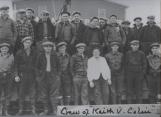 Credits:
Credits:Picture courtesy of Barry Hollett
28
Pearl's father, William Brushett, was a crewmember on the "Keith V. Colin""My Dad wasn't home a the time. He was down in the woods, in the bay they called it, cutting wood for hte winter. And he said if he had been home we would probably been all drowned cause he would have opened the back door and then the water would have rushed in of course and swept us out through, apparently. ah, he didn't hear anything abou it until three days later. He didn't know if we were dead or alive until he got back to Burin....He was a fisherman, so he fished all summer and in the fall they went to the woods to get wood for the winter or the next year. That's where he was when it happened. He hadn't heard anything about it until he got home. I think it was three days before they had heard and he didn't know if we were alive or if we were all gone."
29
Brushett House towed to Ship Cove by the Customs Cutter 'S.S. Daisy'November, 1929
Burin Looking East

30
Centre is the Brushett house moored in Ship CoveMr. & Mrs. Benjamin Hollett took us up to their house. The next wave came in and took the house out through the gut. The lamp was still burning in the kitchen when the old "Daisy" towed it in the next day. It was moored off in Ship Cove for I don't know how long but a while. Our old cat was still in the house but when my uncle went up to the house after it was moored in Ship Cove, the cat jumped out over his head and ran out, swam to shore. So nobody knows what happened to the cat.
32
For the longest time I used to have nightmares...that the water would be... I'd be running and the water would be right at my heels. I'd keep running until I woke up.34
William and Carrie Brushett, Kelly's Cove"After the Tidal Wave, Mom always had a noise in her head that she said sounded like the waves roaring. I guess probably she was in shock but was never treated for it."
35
Mrs. Lottie Matthews (Brushett) resides in Grand Bank, Newfoundland.37
An interview with Lottie Matthews:"I remember the tremor...everything going, dishes rattling. During supper we talked about what had happened and everything looked calm. Suddenly Mom looked out the window and there was water up to the window. Fred (brother) thought it was raining because of all the noise. Mom wanted to wake Pearl and Lilly (she was in bed with an ear ache). I remember Mom had a lamp and that the house was tilted. Mom took the three of us upstairs and we were scared. I can still see Mom with her finger in the Adlandin Lamp. Mom got the five of us and we went back downstairs."
39
"Suddenly we felt the house moving and we ended up on Bartlett's Island. The five of us were screaming because it was so dark and we were afraid. It seemed that we were there for awhile. Then on the third wave it took us back to Kelly's Cove. Then Mom broke the window and we could hear Uncle Ben outside. As we were going out through the window I could see my new coat on the chair in the parlor, but I didn't pick it up. Mom had cut her wrist and I had cut my arm when I tried to get out the window. I still have glass in my arm today. When we jumped out of the window I remember that the water was over my ankles and I was cold because we were in our night dresses. Uncle Ben and Aund Beatie took us to higher ground and we could hear the water rushing."41
Kelly's Cove after the Tidal Wave 1929"Dad wasn't home he was in a Jackboat getting wood. We lost the store, beef...we had nothing. We had to survive off others. We stayed in Kelly's Cove after the Tidal Wave and lived in Willis Mayo's house, because he had moved to Parson's Point. Our house had been brought over to Kelly's Cove and made into a fish stage. We had a cat, she must have jumped out as we didn't see her again.
Mom always had a roaring in her ears after the Tidal Wave. I think she was still in shock and was never treated for it."
43
A photo taken of Lillain, Pearl, and Lottie (Brushett) at Pearl's 80th Birthday"Aunt Beatie and Uncle Ben took us in and they did up the cuts on our arms with flour and molasses and bound it up. The next day I remember Fred picking up coal along the beach with a dress on. Billy Foote gave me a pair of boots. The next day it was snowing and blowing and debis everywhere. It was miserable. I had to go to Foote's Cove in a boat and stay with my aunt."
45
Louise Hollett was twenty-three years old when the tidal wave hit Great Burin." I was in the house. It was about five o'clock. We were getting supper. We had a lady come over to visit us that day and Mom was baking apple dumplings. I heard this noise and I thought it was the stove. We ran out by the door and you could feel the earth shaking under your feet."
47
Photo site of the Telegraph office, Great BurinAfter supper, Louise made her way to the telegraph office. Up and away fromt the beach there was a road called the "high road," but she took the route down by the water. "I went over to hear the news and when I was going over, the harbour went right dry. Darby's boat was there and she was high and dry at the wharf."
"In the post office they used to have telegraphy. Mrs. Helen Darby was the telegraph operator and she had a big news book. The news would come and she would write it all out and then put it out in the lobby. Sometimes she would read it for the crowd of men standing around."
49
After the earthquake, they came over from Shalloway. That's another island they had to come over footbridges to get there. They came over to hear the news and see what was happening."51
"I wasn't over there very long, only a few minutes, when I heard the big rush and the water all rushed in."Luckily, the water did not come up to where Louise was standing.
"The telegraph office was up higher. There were the wharves and then you came upa little bit to what they called the beach. They had beaches, down there where they used to make fish. Then there was an upgrade to the telegraph office."
"Everybody went up on higher ground. And we were scared stiff. The funny thing was, we didn't know what a tidal wave was. We were quite ignorant of what was happening. We thought the place was sinking or something."
"There was a lighthouse keeper up there, from somewhere in England. Sidney Hussey was his name. He told us what was happening. "You know, when there's an earthquake, there is usaully a tidal wave if it is out in the ocean."
Seeing the damage on the beach, the visitors from Shalloway became nervous. They had good reason to be uneasy. "The Shalloway people lived right down on beaches. They thought their houses would be gone. They got the ferry boat that was there and tried to go over to see how their families were and see what was gone. Do you know, they couldn't steer the thing at all, with so much tide. They finally got there and there was hardly a thing damaged."
53
At the telegraph office, Louise was worried. "I was out by the door, looking and listening. Everybody was looking. I didn't know what to do. My mother was home and we lived down near the water. I went home by way of the high road and called out to her. She and this other woman came up over the hill.""Mr. E. Hollett had a store where he used to keep lumber and other things. You could hear all the lumber tumbling out of his store, as the high tide took all his wharves out to sea. Some of the lumber lodged on the bank and in the landwash. All night long we could hear the men trying to salvage it and throw it up on high land."
Great Burin did not sustain as much damage as other villages on Great Burin Island. "It came in there and went down through the Reach and down in Stepaside, but in Kelly's Cove it got pinned there. It brought up there, so they had more damage than the rest. then it went on down to Port au Bras. It sort of passed along by us."
55
Magistrate Malcolm Hollett, Great Burin"Believe it or not, the Magistrate live in Great Burin. He was Malcolm Hollett. He served in the First World War and after the war he was honoured as a Rhodes Scholar and went to England and received his degrees. When he came back he became a Magistrate and later served in the Newfoundland Governent. (He was a strong supporter of a return to Responsible Government, and was opposed to Confederation with Canada.) "He was instrumental in helping organize provisions and help for those affected by the tidal wave. He was my mother's first cousin and it was to his house we went and stayed when the tidal wave was at its worst."
57
"My father, Joseph Emberley, and another man was down to Swift Current cutting wood, because hardly anybody lived there then. The other man had one of these little Jack Boats. They ran up in the bottom, which they call Piper's Hole. That evening, they noticed that the tide was pretty high, and swirling. The boat used to spin around, but he didn't know what was causing it. He didn't know anything about what was happening. But when they were coming home, three days later, they met the wreckage of things and found out it was a tidal wave."59
Marion Kelly, a resident of Kelly's Cove, was thriteen years old when the tidal wave hit. It happened on a Monday, a beautiful day for washing clothes."I was at a woman's house to write a letter for her. She was an old woman. She was writing her daughter, in Boston, I believe. She couldn't write, so I was writing it for her. After the shock( tremor) I wanted to go home. We didn't know what to think really. I didn't stay. If I didn't go when I did, I would have been caught in the wave, going down around the shore on the way home.
61
Marion Kelly Moulton's Story:"Some time after the shock, I was at the kitchen table working by the light of a kerosene lamp. I was still in my school clothes, a navy skirt and white blouse. I was doing my homework. I was doing English. You know the sentence I was doing? "If you do not leave the house, I will send for the policeman with that fine." Of course, we didn't expect a tidal wave. we didn't know anything about it, really. It came round seven o'clock. They say that the harbour dried out. Whether it did or not I really don't know, but that' what people said. Then it came back in. Well, you could hear the sea coming in. It was roaring. Of course we all ran out in the yard to see what was going on. the sea was just like a mountain coming, but slowly. That's what it seemed like to me. Right straight. There were three waves. My little brother and sister were in the doorway. I ran and got him and ran behind the house and jumped the fence. Id really don't know how high. When I got over the fence the water was coming underneath it. I don't know how I did it. Because Elroy was biggish. He didn't remember anything though, he never did. He was only three and a half. When I got over the fence I looked back and the house was just going with the light in the window.
63
Mom came out in the yard. I don't know if she went back in the house or not, I never knew. Mother and my little sister didn't make it. they never did fin my mother Frances, or my sister Dorothy. I took everything when it came. Later, the schooner "Daisy" was in here at the government wharf. The "Daisy went out looking. She towed in a house, but it was not ours. In Kelly's Cove three or four hosues washed out. Mrs. Carrie Brushett and her five children were in one. the first wave came and tookt he house and took it out to sea and they were all in it. The second wave came and brought it back adn put it on the beach. then they all got out before the thrid wave came and took the house right out to sea.""My other brother Curt was at my aunt's house at the time. I raised them up, the two boys, Elroy and Curt."
"Father was down in the woods. We had a big schooner, and he was down getting wood for the inwter. He didn't know a thing about it until he got home, a week later."
65
The homes were built close to the shorelines for easy access to the family flakes and stages. Oliver Inkpen (Oli), married to Stella Foote from Step a Side, lived in the first home on the left side while his brother, Teed Inkpen lived next door. Teed, known as Uncle Teed, married Lena Parsons, a school teacher from Great Burin.67
During the Tidal Wave, Emmanuel Inkpen and his wife, both sick at the time, were swept away from land in their houses. Stella's brother, Chesley Foote, a cripple with an artificial leg, being the only man nearby, forgetting his own safety, took a broken and leaky dory and rescued the Inkpens from certain death by getting them out of the house through a window.69
"What One Woman Remembers" Part IStella Foote, born 1890 at Stepaside, resided in Shalloway with her husband, Oliver Inkpen. She vividly remembered November 18th, 1929. The first tremor occurred, around four in the afternoon. She thought the rocky mountain behind her home was experiencing a landslide. Running out with her two month old baby in her arms she was met by her two other children and a nephew amazed at the motion of the ground beneath their feet. When the tremor appeared to have passed, Oliver and his brother walked to great Burin by way of connecting bridges. They were barely able to reach safety in Great Burin when a tidal wave struck. It was getting dark and by the light of an oil lamp, Stella was ironing baby clothes, when she heard an awful swishing soulnd, and looking out the window, saw the boiling white water sweep away the bridges. She thought her husband was drowned. She gathered the children together and Uncle Tom Moulton and another man urged her to hurry to higher ground. One of them took the baby in her cradle and one took four-year old Hazel and they all went up the hill to Stella's mother-in-law's house. they had just left the beach when the second wave struck. It was worse than the first becasue it swept away many houses and stages which were in its path.
71
Part II: "What One Woman Remembers "After the second wave struck, Oliver and his brother tried to return to Shalloway by using a small boat which was sometimes used as a ferry and started out. They met the third wave which tossed the boat around but they finally reached their stage which was miraculously still there. When Stella had left the house to run to higher grounds, Stella had blown out the lamp, thus leading Oliver to believe that the house was gone in the wave. Yet, it too was miraculously still there. Around two o'clock in the night at the harbour area, the water was invisible: covered by a solid bridge comprised of floating wharves, stores, warehouses, flakes, boats and debris. By daylight they were amazed to see floating barrels of pork, beef, molasses and eveything imaginable that had been let loose from the stores and business firms.73
P.J. Antle's StoryThe 18th of November, 1929 was a beautiful cool, sunny day. I was nineteen years old at the time, and every last detail of that terrible night stands out vividly in my memory, never to be forgotten.The fishing communities on the Burin Peninsula were a bee-hive of industry taht day; men were engaged in the usual variety of tasks, landing and storing fuel and food supplies, and securing small boats for winter. As the only means of transportation was by sea, the custom was to lay in supplies of food in the fall sufficient to last until spring. Women called to each other from gardens where the last vegetable were taken and stored. Children returning from school romped and played, and plucked bunches of bright red dog-berries from trees along the road.
75
The scenic beauty of the place could be described in two words "gentle tranquility." Little did they know that death and destruction lay poised to strike and, like some savage beast of the jungle, waited for the darkness that would add to the terror of its attack.77
Mr. & Mrs. Pat Antle (author)The Earth Trembled
The first shock was felt at five o'clock in the evening. I was returning from a hsopping errand when I heard the first rumbling noise. It sounded like an airplane int he distance. In a few seconds the earth began to tremble violently as the noise increased to a deafening roar. People spilled from houses nearby. With hardly a single exception everyone looked towards their roofs; I learned later that householders were convinced that hte noise and shaking was the result of a chimney fire or explosion. The shock passed as suddenly as it had come, leaving hte poeple ina tstate of wonderment. Little groups gathered here and there and discussed the thing that had invaded the peaceful serenity. All sorts of ideas were xpressed some bordering ont he fantastic. What seemed to be the most logical explanation was expressed by a man who had been in Halifax at the time of the Mount Blanch explosion. He suggested that it might have been an explosion of a ship at Burin, seven miles distant, carrying a load of oil or other explosives.
79
Photo: Bert Winter's house, Burin, Newfoundland.Meanwhile, darkness settled. As was the custom, people gathered in each others houses to play cards, or discuss the day's events. At the home of a friend a group of eight had commenced a game of auction fory fives, Newfoundland's most popular card game. Suddenly, from outside, someone shouted that the place was sinking; there was a scramble for the door. As we reached the outside we saw the first giant wave sweeping in over the land. Like a great black monster it came, tearing in, sweeping everything before it. I judged it to be about thirty feet high. Words fail to descibe the chaos of the next minutes. Pnademonium, such as we had never before witness broke loose. The wave tore boats from their anchorage, ripped buildings from their foundations, and flooded the floors of houses great distances inland. The noise of smashing timber, the roar of the sea, the movemnt of thousands of tons of rocks and beach gravel, the screams of horrified people, all blended into one indescribable crescendo. It seemed as if all the demons in Hell were let loose.
81
Photo Courtesy Provincial Archives: Bridge Point Cove, Port au Bras, NewfoundlandIn the midst of tragic incidents and narrow escapes, heroism played its part. Men, with complete disregard for their personal safety, plunged into the roaring waters, desperate attempts to rescue helpless women and children who were trapped in threatened houses. Daredevil bravery was responsible for saving many lives. One feature of the event, and I fear my readers may not accept this as logical, is I am convinced to this day that the water was warm. Whether this feeling was the result of physical shock, I cannot tell. With a friend, I waded waist high in the water in an attempt to rescue an old woman trapped in a house surrounded by water. It was then that I experienced the strange feeling that the water was warm.
